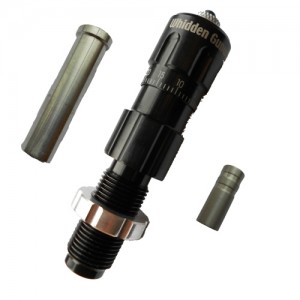Product Description
Have you ever wondered why the hole in the front of the bullet is so big? Why can’t it be made more pointed? The solution to this lies in the bullet pointing die.
A bullet pointing die is a die used to make a sharper point on a bullet. By doing this, we have made the bullet fly more efficiently resulting in less drop and wind drift. Who can benefit from this? Pretty much every rifle shooter who shoots at longer ranges can.
Let’s back up a second for a quick history lesson. In recent years, 1000 yard benchrest shooters have proven beyond a doubt that we can shoot better groups by making our bullets more consistent. Ballistic Coefficient (BC) is a measure of how aerodynamic our bullets are. The BC is a relative measure that lets us compare one bullet type to the next. A higher BC is desirable because it means the bullet will shoot flatter and have less wind drift.
As you can understand, we also need the BC to be consistent from one bullet to the next, within the same box, so they will drop the same amount as they go down range.
The most inconsistent surface on a bullet is the tip (called the meplat). Again, the 1000 yard benchrest shooters have developed a solution. It has become popular to trim the meplats in recent years so that each one has exactly the same shape at the meplat. Undoubtedly this has made the bullets more consistent and therefore the groups have gotten smaller.
The down side is that by trimming the meplat, we have also made it larger. This causes a lower BC and increases drop and wind drift. Generally speaking, for typical bullets used in long range competition, trimming means you give up about five percent more wind drift as compared to bullets right out of the box.
With our bullet pointing die, we can make the meplat smaller rather than bigger. Consider that a little pointing will do a lot of good. Typically with the bullet pointing die, we can close the meplat up to about half of its original diameter. Here’s the kicker-by closing it to half of the diameter, the surface area is only one fourth of its original amount. This is the reason the pointing die is so effective.
How effective is it? Again talking about bullets typical for long range competition, we can gain about five percent better wind drift compared to bullets right out of the box. We are also getting an increased consistency of BC because we have reduced the size of the imperfections at the meplat. Better accuracy down range and better performance is a winning combination.
Let’s compare trimming meplats with pointing them. Since trimming yields a five percent reduction in performance and pointing yields a five percent increase in performance, there is a ten percent difference between the two. How big is a ten percent difference? A 6.5-284 is about ten percent better than a 6mmBR at 1000 yards. You can actually point your 6mm BR’s bullets and be on equal footing with a 6.5-284. This is a huge difference for just pointing a bullet.
As you can imagine, the larger the meplat is to start with, the more pointing the bullet will help. Consider also that the meplat of a .224 bullet is a greater portion of the frontal area than a .338 bullet. For this reason, the gain seen by the smaller diameter bullets is more. Some shooters have seen their .223s shoot 2.5 MOA flatter at 1000 yards just by pointing the bullet. If you’re an AR-15 service rifle shooter, the potential gain is very large. Lead tipped hunting bullets also show significant gains such as this.
What do I need to have this ten percent performance gain? All you need is a reloading press and a shellholder appropriate for a .308 Winchester. Forster Co-Ax presses work great, too. Our pointing die will include everything else you need. Using a lube such as Imperial Sizing Die Wax seems to smooth out the process, but is not necessary. If you want to point more than one caliber, simply purchase an extra bullet guide for the new caliber. These guides can be changed easily and you’re in business. The die features a micrometer style adjustment that allows you to record a setting for each caliber for easy return to that previous setting.
Pointing bullets goes quickly, too. Setup is no more difficult than setting up a micrometer type seating die. Bullets can be pointed at about the same rate as you can size brass.
Understand that bullets can’t be pointed up to a needle point. The smallest practical diameter that a bullet can be pointed to is about twice the thickness of its jacket. As a practical matter, about .030” to .040” is about the limit.
Additional Information
| Pointing Die | INSERT NO 0, INSERT NO 1, INSERT NO 2, SLEEVE .22 CAL, SLEEVE .30 CAL, SLEEVE .338 CAL, SLEEVE 6.5MM, SLEEVE 6MM, SLEEVE 7MM |
|---|




Reviews
There are no reviews yet.